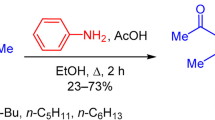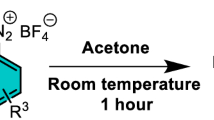Abstract
It is shown that the direction of chlorination of 1,3-dioxolan-4-ones in the presence of benzoyl peroxide is determined by the nature of the substituent at the 5-position of the ring. In this case a chloromethyl group, having a —I effect, promotes a selective replacement of hydrogen at the 2-position, while a methyl group mainly causes replacement of hydrogen at the 5-position.
Similar content being viewed by others
Literature cited
P. Salomaa and S. Laiho, Acta Chem. Scand., 17, 103 (1963).
M. I. Khramushina, V. R. Likhterov, V. S. Etlis, and D. K. Chuprov, USSR Inventor's Certificate No. 609,290; Byull. Izobret., No. 6, 215 (1984).
E. Bear and H. Fischer, J. Biol. Chem., 180, 145 (1949).
V. R. Likhterov, V. S. Étlis, L. A. Balandina, and S. A. Arzhakov, USSR Inventor's Certificate No. 606,313; Byull. Izobret., No. 6, 215 (1984).
Additional information
Translated from Khimiya Geterotsiklicheskikh Soedinenii, No. 2, pp. 187–189, February, 1986.
Rights and permissions
About this article
Cite this article
Likhterov, V.R., Étlis, V.S. Chlorination of 1,3-dioxolan-4-ones. Chem Heterocycl Compd 22, 145–147 (1986). https://doi.org/10.1007/BF00519932
Received:
Revised:
Issue Date:
DOI: https://doi.org/10.1007/BF00519932




